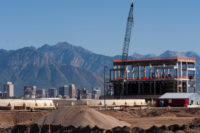Bill Wyatt, executive director of Salt Lake City International Airport, placed a copy of the facility’s long-range plan into a time capsule on Oct. 27 as part of an event marking the official closing of the city's 60-year-old airport terminal and the launch of Concourse B, just north of the old facility.
The opening of the second concourse of airline gates marks another significant step toward final completion of the $4.1-billion project that broke ground in July 2014.
“This copy of the 1996 master plan has a rendering on the cover of a facility imagined many years ago that looks remarkably like the one we are opening today,” Wyatt said. “Since 1996, we and our partners have been gradually taking steps to get here. The reality is, today, with the opening of this concourse, we are kind of done.”
The last plane departed from the old airport, directly adjacent to the new facility, just after midnight. All operations then officially transitioned to the new terminal. The majority of new airport operations began on Sept. 15, while work on Concourse B, with its 21 gates and eight shops and restaurants, was still being finished.
Concourse B, or the North Concourse, was added as a component of the terminal replacement program in 2016. The addition and unexpected labor and materials costs pushed the budget for the terminal replacement from $1.8 billion to $3.6 billion.
The joint venture team of Okland Construction, Salt Lake City, and Dallas-based Austin Commercial, known as Austin-Okland Aviation, was awarded the concourse construction-management-at-risk contract in 2017 and broke ground in 2018.
Thinking Ahead
Early plans for the new airport anticipated need for the north concourse. During airside improvements in 2004, the nearly 1,000-ft-long tunnel was built and sealed until needed for the terminal replacement. Tunnel walls now are painted with murals featuring stylized local landscapes and wildlife as well as an interpretation of the four seasons in Utah.
Contractor Program Director Dave Francom and Construction Manager Chandler McClellan said the team has managed multiple challenges along the way.
“Initially, there was the problem of getting enough people on the job. We are competing for workers against some other big projects near here,” Francom said.
At the project’s peak, 580 craft workers were on site, all trying to comply with COVID-19 protocols, McClellan said.
“Then we had the earthquake to deal with,” he added, referring to the 5.7 magnitude tremor that hit the area in March. “We were working on the ceiling at that time, and we had tiles falling out all over." He said shutdowns related to COVID-19 also impacted delivery of materials. "We just had to adjust and rearrange how we did things," said McClellan. "We were able to deliver this on budget and ahead of the original schedule.”
Schedule Pushed Up
Project planners had originally planned to keep some gates at the old facility operating while new gates were completed. But as passenger numbers dropped due to the COVID-19 slowdown, the project team accelerated the schedule.
“With construction, time is money, and we have been able to make substantial savings by pushing this and getting it open earlier,” said Wyatt., noting that the contractor "really came through here and made this work.”
The 21 new gates of Concourse B will be complemented by 15 “hard-stand” gates located just outside the concourse. Those gates are serviced by shuttles and used mostly by small regional airlines. As the old airport is demolished, the A and B concourses will be expanded when demand increases, with complete build-out expected sometime in 2024.


